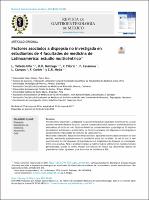Mostrar el registro sencillo del ítem
Factors associated with uninvestigated dyspepsia in students at 4 Latin American schools of medicine: A multicenter study
| dc.contributor.author | Talledo-Ulfe, L | |
| dc.contributor.author | Buitrago, OD | |
| dc.contributor.author | Filorio, Y | |
| dc.contributor.author | Casanova, F | |
| dc.contributor.author | Campos, L | |
| dc.contributor.author | Cortes, F | |
| dc.contributor.author | Mejia, CR | |
| dc.date.accessioned | 2019-09-08T18:20:58Z | |
| dc.date.available | 2019-09-08T18:20:58Z | |
| dc.date.issued | 2018 | |
| dc.identifier.uri | https://hdl.handle.net/20.500.12692/36127 | |
| dc.description.abstract | Introduction and aims: Dyspepsia is a multifactorial disease that can involve alcohol, tobacco, or nonsteroidal anti-inflammatory drug use, as well as lifestyle, diet, socioeconomic elements, or psychologic factors. The aim of the present article was to establish the frequency of uninvestigated dyspepsia and determine its associated factors in students at 4 Latin American schools of medicine. Materials and methods: A cross-sectional, analytic study was conducted, in which a survey made up of closed-ended questions was applied at just one point in time. The association between the variables was then analyzed. A new questionnaire for the diagnosis of dyspepsia was one of the tests utilized to diagnose uninvestigated dyspepsia. Generalized linear models were used for the bivariate and multivariate analyses, employing the Poisson model with the log link function, obtaining crude prevalence ratios, adjusted prevalence ratios, and their 95% confidence intervals. Results: Of the 1,241 individuals surveyed, 54% (841) were females and the median age was 21 years (range: 19-23 years). Prevalence of uninvestigated dyspepsia was 46%. The factors that had a direct association with dyspepsia were: depression, difficulty sleeping, and coffee consumption. On the contrary, eating regularly in a boarding house and the mate sex had an inverse association. Conclusions: Uninvestigated dyspepsia frequency was high in students at 4 Latin American schools. Depression, difficulty sleeping, and steady coffee drinking were factors directly associated with dyspepsia, whereas male sex and eating out at regular hours were factors with a reverse association. Therefore, we recommend that universities implement early detection programs for this highly preventable pathology. Published by Masson Doyma Mexico S.A. on behalf of Asociacion Mexicana de Gastroenterologia. This is an open access article under the CC BY-NC-ND license (http://creativecommons.org/licenses/by-nc-nd/4.0/). | en_US |
| dc.description.abstract | Introducción y objetivos: La dispepsia es una enfermedad de naturaleza multifactorial, ya que podrían intervenir distintos factores, como el consumo de alcohol, tabaco o antiinflamatorios no esteroideos, el estilo de vida, factores dietéticos, socioeconómicos y psicológicos. El objetivo es establecer la frecuencia y determinar los factores asociados con dispepsia no investigada en estudiantes de 4 facultades de medicina de Latinoamérica. Materiales y métodos: Estudio transversal analítico, aplicando una encuesta cerrada en un solo periodo, analizando posteriormente la asociación entre las variables. Se usó el test A new questionnaire for the diagnosis of dyspepsia para el diagnóstico de dispepsia no investigada, entre otras pruebas. Para el análisis bivariado y multivariado se utilizaron los modelos lineales generalizados, usando la familia Poisson con función de enlace log, obteniendo razones de prevalencia crudas, ajustadas y sus intervalos de confianza al 95%. Resultados: De los 1,241 encuestados, el 54% (841) fueron del sexo femenino y la mediana de edad fue de 21 a˜nos (rango 19-23 a˜nos). La prevalencia de dispepsia no investigada fue del 46%. Los factores que tuvieron una asociación directa a la dispepsia fueron: depresión, problemas para conciliar el sue˜no y el consumo de café. Por el contrario, comer regularmente en una pensión y el sexo masculino tuvieron una asociación inversa. Conclusiones: La frecuencia de dispepsia no investigada fue alta en estudiantes de 4 escuelas latinoamericanas. La depresión, la dificultad para dormir y el consumo constante de café fueron factores que se asociaron directamente con la dispepsia, mientras que el sexo masculino y el comer regularmente en una pensión fueron factores con una asociación inversa. Por lo tanto, recomendamos que las universidades implementen programas de detección temprana para esta patología altamente prevenible. | es_PE |
| dc.format | application/pdf | es_PE |
| dc.language.iso | spa | es_PE |
| dc.publisher | Doyma Mexico S.A. | es_PE |
| dc.relation.uri | https://www.ncbi.nlm.nih.gov/pubmed/29706421 | es_PE |
| dc.rights | info:eu-repo/semantics/openAccess | es_PE |
| dc.rights.uri | https://creativecommons.org/licenses/by/4.0/ | es_PE |
| dc.source | Repositorio Institucional - UCV | es_PE |
| dc.source | Universidad César Vallejo | es_PE |
| dc.subject | Dyspepsia | es_PE |
| dc.subject | Medical students | es_PE |
| dc.subject | Association | es_PE |
| dc.subject | Coffee | es_PE |
| dc.subject | Functional dyspepsia | es_PE |
| dc.subject | Prevalence | es_PE |
| dc.title | Factors associated with uninvestigated dyspepsia in students at 4 Latin American schools of medicine: A multicenter study | es_PE |
| dc.title.alternative | Factoresasociadosadispepsianoinvestigadaenestudiantesde4facultadesdemedicinadeLatinoamérica:estudiomulticéntrico | es_PE |
| dc.type | info:eu-repo/semantics/article | es_PE |
| thesis.degree.grantor | Universidad César Vallejo. Facultad de Ciencias de la Salud | es_PE |
| dc.description.sede | Ate | es_PE |
| dc.description.peerreview | Revisión por pares | es_PE |
| dc.contributor.email | christian.mejia.md@gmail.com | es_PE |
| dc.identifier.doi | https://doi.org/10.1016/j.rgmx.2017.05.009 | |
| dc.subject.ocde | https://purl.org/pe-repo/ocde/ford#3.01.00 | es_PE |
Ficheros en el ítem
Este ítem aparece en la(s) siguiente(s) colección(es)
-
Ate [1]


